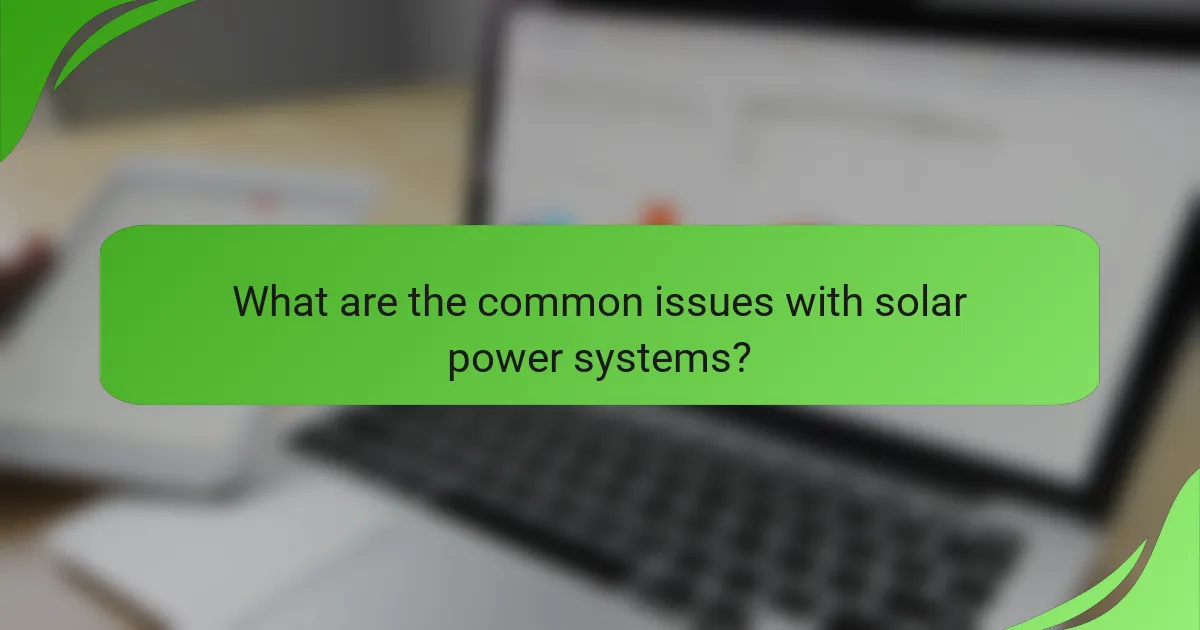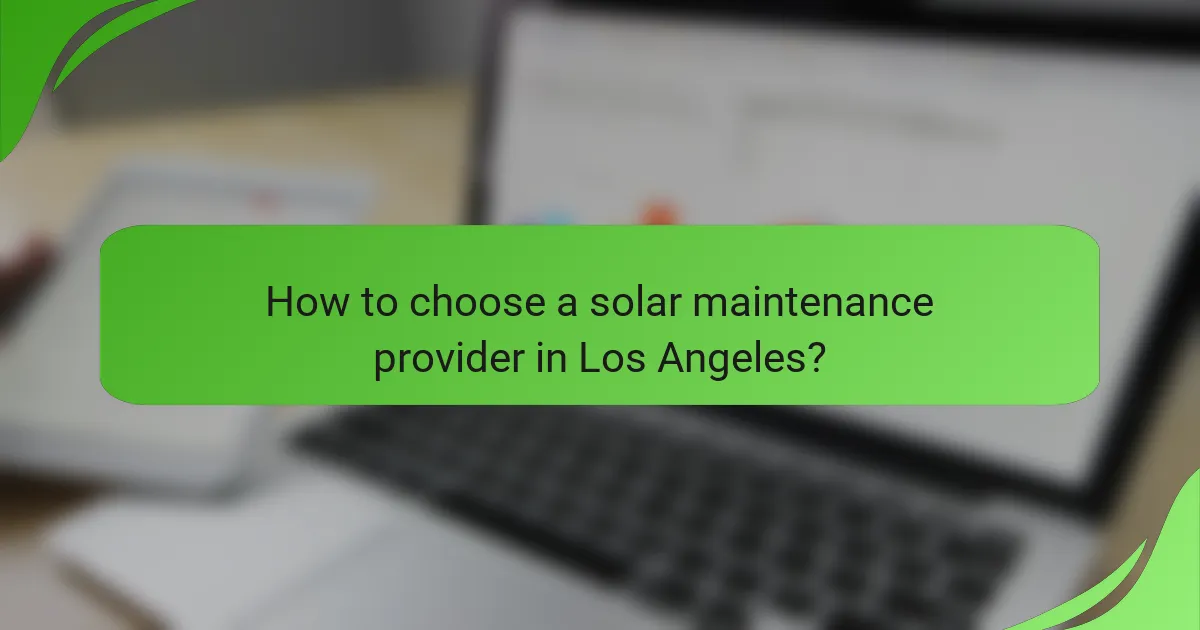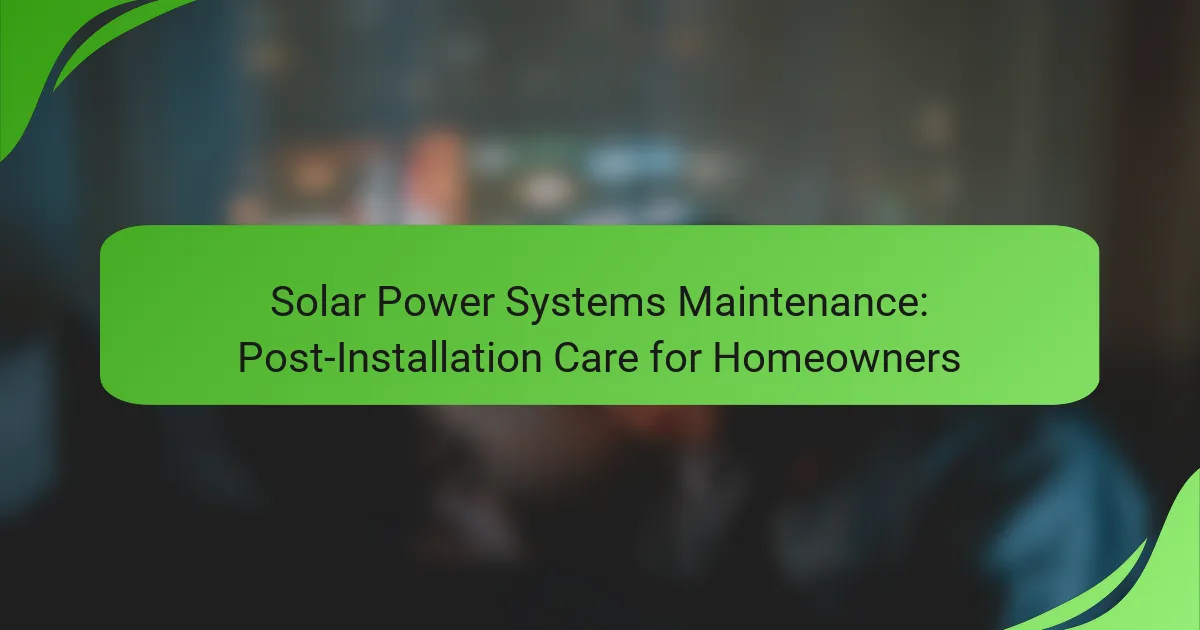Proper maintenance of solar power systems is essential for homeowners to ensure optimal performance and longevity. This involves regular cleaning, routine inspections, and monitoring energy production to maximize efficiency. By understanding common issues and scheduling annual maintenance, homeowners can effectively care for their systems and address potential problems before they escalate.

How to maintain solar power systems in California
Maintaining solar power systems in California involves regular cleaning, routine inspections, and monitoring energy production to ensure optimal performance. These steps help homeowners maximize energy efficiency and prolong the lifespan of their solar panels.
Regular cleaning of solar panels
Regular cleaning of solar panels is essential to remove dust, dirt, and debris that can block sunlight and reduce efficiency. In California, where dust and pollen can accumulate, it is advisable to clean panels at least twice a year, or more frequently in particularly dusty areas.
When cleaning, use a soft brush or sponge with mild soap and water. Avoid harsh chemicals that could damage the panels. If you are uncomfortable cleaning them yourself, consider hiring a professional service to ensure a thorough job without risking damage.
Routine inspections for damage
Routine inspections for damage should be conducted at least once a year to identify any issues such as cracks, loose connections, or corrosion. Homeowners can visually inspect the panels for any visible signs of wear or damage, especially after severe weather events.
During these inspections, check the mounting hardware and wiring for any signs of rust or wear. If any issues are found, it is crucial to address them promptly to avoid further damage and ensure the system operates efficiently.
Monitoring energy production
Monitoring energy production is vital for understanding the performance of your solar power system. Most modern systems come with monitoring software that allows homeowners to track energy output in real-time, making it easier to spot any significant drops in production.
Regularly reviewing energy production data can help identify potential issues early. If you notice a consistent decrease in output, it may indicate a need for cleaning, repairs, or even a system upgrade. Keeping an eye on these metrics ensures that your investment continues to yield optimal returns.

What are the common issues with solar power systems?
Common issues with solar power systems include inverter failures, panel degradation, and wiring problems. Understanding these challenges can help homeowners maintain their systems effectively and ensure optimal performance.
Inverter failures
Inverters are crucial components that convert the direct current (DC) generated by solar panels into usable alternating current (AC) for home appliances. Common causes of inverter failures include overheating, electrical surges, and aging components. Regular monitoring can help identify issues early, potentially avoiding costly repairs.
Homeowners should check their inverter’s display regularly for error codes or warning lights. If any issues arise, consult the manufacturer’s manual for troubleshooting steps or contact a professional for assistance.
Panel degradation
Solar panels can degrade over time, typically losing efficiency at a rate of about 0.5% to 1% per year. Factors contributing to degradation include exposure to extreme weather, dirt accumulation, and physical damage. Regular cleaning and inspections can help maintain panel efficiency.
Homeowners should schedule annual professional inspections to assess panel condition and performance. If efficiency drops significantly, consider consulting a specialist to evaluate whether repairs or replacements are necessary.
Wiring problems
Wiring issues can lead to decreased system performance or even safety hazards. Common problems include loose connections, damaged cables, and corrosion. Regular inspections can help identify these issues before they escalate into major failures.
Homeowners should ensure that all wiring is properly secured and protected from environmental factors. If any signs of wear or damage are detected, it is advisable to hire a qualified electrician to address the issue promptly.

How often should homeowners schedule maintenance?
Homeowners should schedule maintenance for their solar power systems at least once a year to ensure optimal performance and longevity. Regular checks help identify potential issues early, allowing for timely repairs and adjustments.
Annual maintenance checks
Annual maintenance checks are essential for assessing the overall health of your solar power system. During these inspections, professionals typically evaluate the inverter, wiring, and connections, ensuring everything operates efficiently.
Homeowners should look for certified technicians who follow industry standards, such as those set by the North American Board of Certified Energy Practitioners (NABCEP). This ensures that the maintenance is thorough and adheres to best practices.
Bi-annual cleaning recommendations
Bi-annual cleaning of solar panels is recommended to remove dust, debris, and other obstructions that can reduce efficiency. In areas with heavy pollen or dust, more frequent cleaning may be necessary to maintain optimal energy production.
Homeowners can clean the panels themselves using a soft brush and water or hire a professional cleaning service. Avoid using harsh chemicals or abrasive materials that could damage the surface of the panels. Regular cleaning can improve energy output by several percentage points, making it a worthwhile investment.

What tools are needed for solar panel maintenance?
To effectively maintain solar panels, homeowners need a few essential tools that ensure cleanliness and functionality. Key tools include soft-bristle brushes, a water hose with low pressure, and a multimeter for electrical checks.
Soft-bristle brushes
Soft-bristle brushes are crucial for gently cleaning solar panels without scratching the surface. They help remove dust, dirt, and debris that can accumulate and block sunlight, reducing efficiency. Look for brushes specifically designed for solar panel cleaning, as they typically have longer handles for safe reach.
When using a soft-bristle brush, work from the top of the panel downwards to avoid pushing dirt into the edges. Clean your panels at least twice a year or more frequently if you live in a dusty area or have nearby trees.
Water hose with low pressure
A water hose with low pressure is essential for rinsing off the panels after brushing. High-pressure water can damage the panels or dislodge connections, so it’s important to keep the pressure low. A simple garden hose with a spray nozzle set to a gentle stream is usually sufficient.
When rinsing, start at the top and work your way down, ensuring that all cleaning residues are washed away. This method helps maintain the panels’ efficiency and extends their lifespan.
Multimeter for electrical checks
A multimeter is a valuable tool for monitoring the electrical performance of your solar panels. It allows homeowners to check voltage and current output, ensuring the system is functioning correctly. Regular checks can help identify issues before they become significant problems.
To use a multimeter, set it to the appropriate voltage range and connect the probes to the panel terminals. Ideally, perform these checks during peak sunlight hours to get accurate readings. If you notice significant discrepancies from expected outputs, it may be time to consult a professional for further inspection.

How to choose a solar maintenance provider in Los Angeles?
Choosing a solar maintenance provider in Los Angeles involves evaluating their qualifications, reputation, and service offerings. Focus on finding a provider that meets local regulations and has a proven track record of customer satisfaction.
Check certifications and licenses
Ensure that the solar maintenance provider holds the necessary certifications and licenses required in California. Look for certifications from recognized organizations such as the North American Board of Certified Energy Practitioners (NABCEP), which indicates a level of expertise and professionalism.
Additionally, verify that the provider is licensed to operate in California. This includes checking for a valid contractor’s license, which can be confirmed through the California Contractors State License Board (CSLB) website.
Read customer reviews
Customer reviews provide insight into the reliability and quality of service offered by a solar maintenance provider. Look for feedback on platforms like Google, Yelp, or Angie’s List to gauge customer satisfaction and common issues.
Pay attention to both positive and negative reviews. A provider with consistently high ratings and responsive customer service is likely to be a better choice than one with mixed reviews or complaints about unresponsiveness.
Compare service packages
When comparing service packages, consider what is included in each offering. Common services may include regular inspections, cleaning, repairs, and monitoring of solar system performance.
Request detailed information on pricing and what each package covers. Some providers may offer basic maintenance at a lower cost, while others may include more comprehensive services that justify a higher price. Make sure to assess which package aligns best with your needs and budget.
